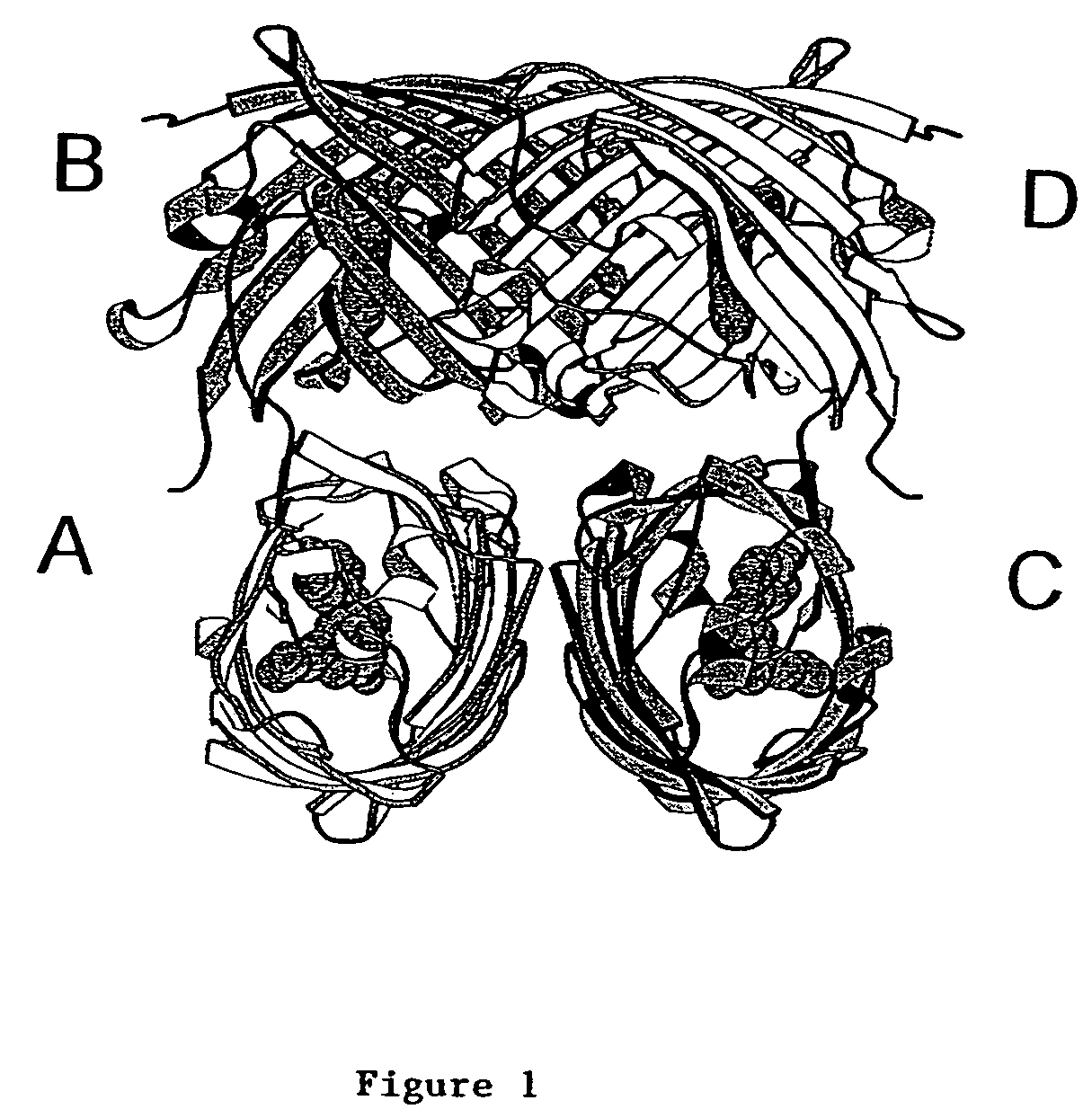Non-oligomerizing tandem fluorescent proteins
a tandem fluorescent protein and fluorescent protein technology, applied in the field of fluorescent proteins, can solve the problems of difficult in some cases to confirm whether, limit the use of fluorescent proteins, formation of non-fluorescent proteins, etc., and achieve the effect of reducing or eliminating the ability of fluorescent proteins to oligomerize, reducing or eliminating the propensity to oligomeriz
- Summary
- Abstract
- Description
- Claims
- Application Information
AI Technical Summary
Benefits of technology
Problems solved by technology
Method used
Image
Examples
example 1
Preparation and Characterization of Non-oligomerizing Fluorescent Proteins
[0133]This example demonstrates that mutations can be introduced into GFP spectral variants that reduce or eliminate the ability of the proteins to oligomerize.
[0134]ECFP (SEQ ID NO: 6) and EYFP-V68L / Q69K (SEQ ID NO: 10) at the dimer interface were subcloned into the bacterial expression vector pRSETB (Invitrogen Corp., La Jolla Calif.), creating an N-terminal His6 tag on the of ECFP (SEQ ID NO: 6) and EYFP-V68L / Q69K (SEQ ID NO: 10), which allowed purification of the bacterially expressed proteins on a nickel-agarose (Qiagen) affinity column. All dimer-related mutations in the cDNAs were created by site-directed mutagenesis using the QuickChange mutagenesis kit (Stratagene), then expressed and purified in the same manner. All cDNAs were sequenced to ensure that only the desired mutations existed.
[0135]EYFP-V68L / Q69K (SEQ ID NO: 10) was mutagenized using the QuickChange kit (Stratagene). The overlapping mutagen...
example 2
Characterization of the Coral Red Fluorescent Protein, DsRed and Mutants Thereof
[0149]This example describes the biochemical and biological characterization of DsRed and DsRed mutants.
[0150]The coding sequence for DsRed was amplified from pDsRed-N1 (Clontech Laboratories) with PCR primers that added an N terminal Bam HI recognition site upstream of the initiator Met codon and a C terminal Eco RI site downstream of the STOP codon. After restriction digestion, the PCR product was cloned between the Bam HI and Eco RI sites of pRSETB (Invitrogen), and the resulting vector was amplified in DH5α bacteria. The resulting plasmid was used as a template for error-prone PCR (Heim and Tsien, Curr. Biol. 6:178-182, 1996, which is incorporated herein by reference) using primers that were immediately upstream and downstream of the DsRed coding sequence, theoretically allowing mutation of every coding base, including the initiator Met. The mutagenized PCR fragment was digested with Eco RI and Bam H...
example 3
DsRed Variants Having Reduced Propensity to Oligomerize
[0182]This example demonstrates that mutations corresponding to those introduced into GFP variants to reduce or eliminate oligomerization also can be made in DsRed to reduce the propensity of DsRed to form tetramers.
[0183]In view of the results described in Example 1 and guided by the DsRed crystal structure, amino acid residues were identified as potentially being involved in DsRed oligomerization. One of these amino acids, isoleucine-125 (I125), was selected because, in the oligomer, the I125 residues of the subunits were close to each other in a pairwise fashion; i.e., the side chain of I125 of the A subunit was about 4 Angstroms from the side chain of I125 of the C subunit, and the I125 residues in the B and D subunits were similarly positioned (see FIG. 1). In addition, the area in which the I125 side chains reside exhibited hydrophobicity, analogous to that identified in Aequorea GFP variants, which was demonstrated to be ...
PUM
 Login to View More
Login to View More Abstract
Description
Claims
Application Information
 Login to View More
Login to View More - R&D
- Intellectual Property
- Life Sciences
- Materials
- Tech Scout
- Unparalleled Data Quality
- Higher Quality Content
- 60% Fewer Hallucinations
Browse by: Latest US Patents, China's latest patents, Technical Efficacy Thesaurus, Application Domain, Technology Topic, Popular Technical Reports.
© 2025 PatSnap. All rights reserved.Legal|Privacy policy|Modern Slavery Act Transparency Statement|Sitemap|About US| Contact US: help@patsnap.com


